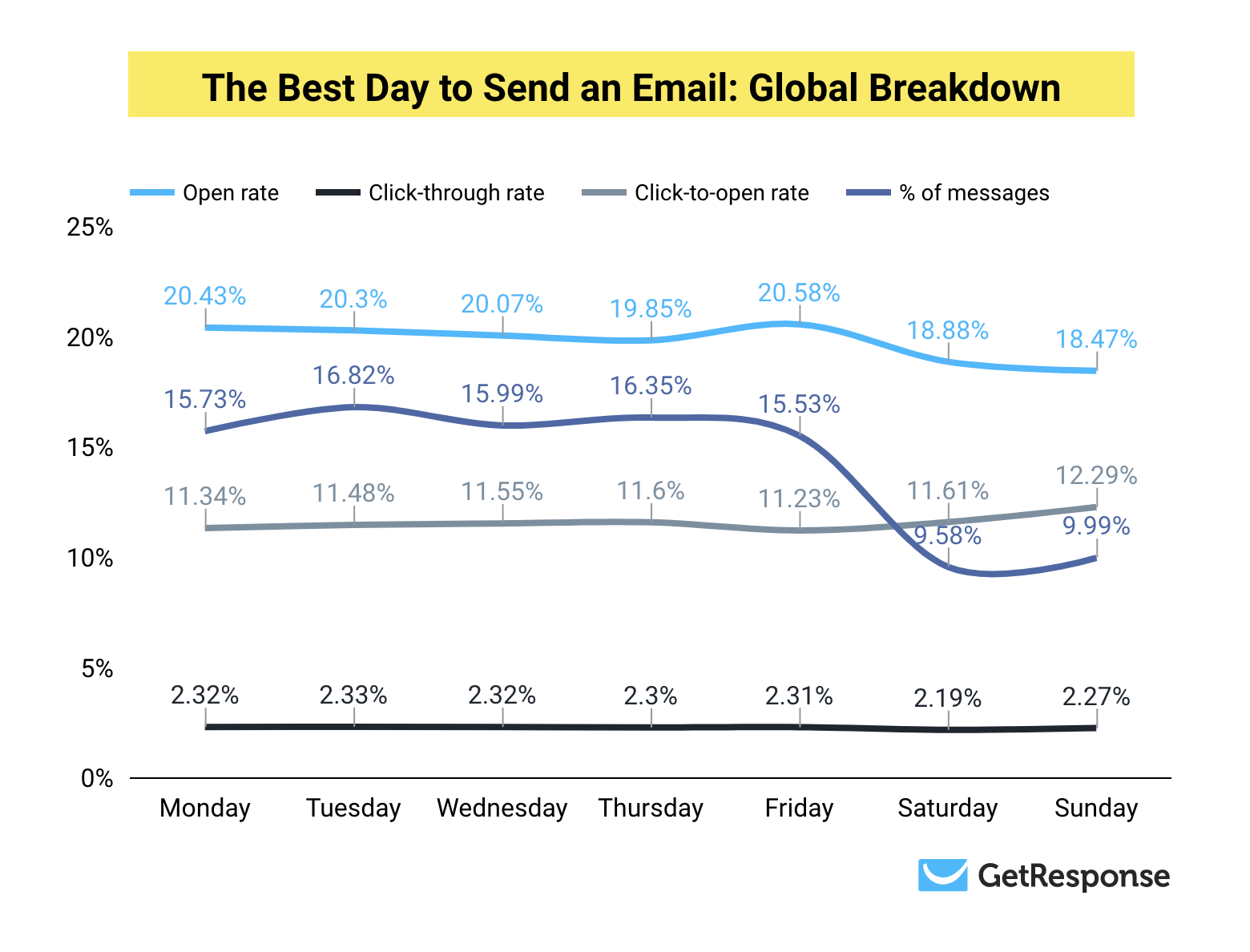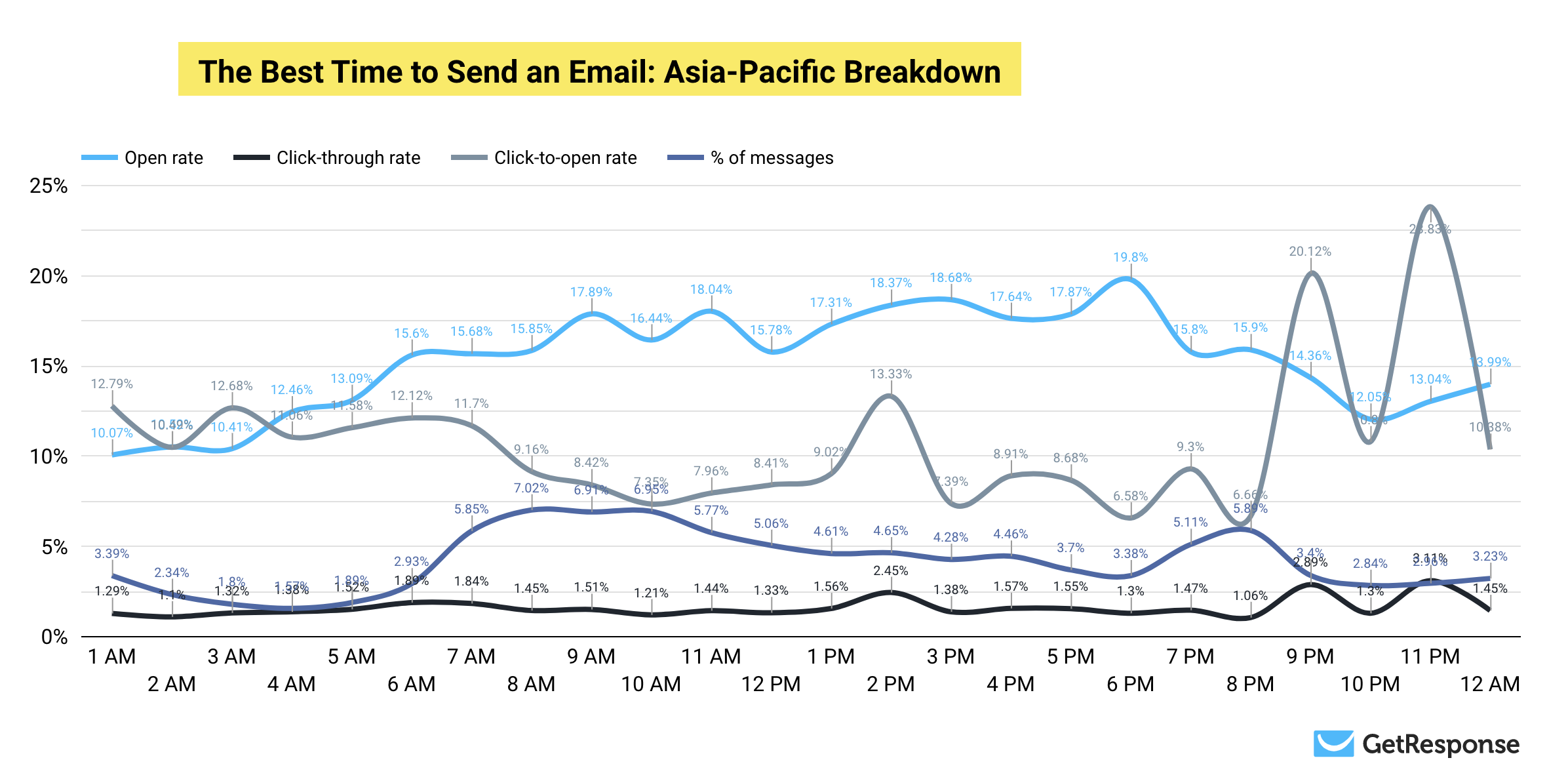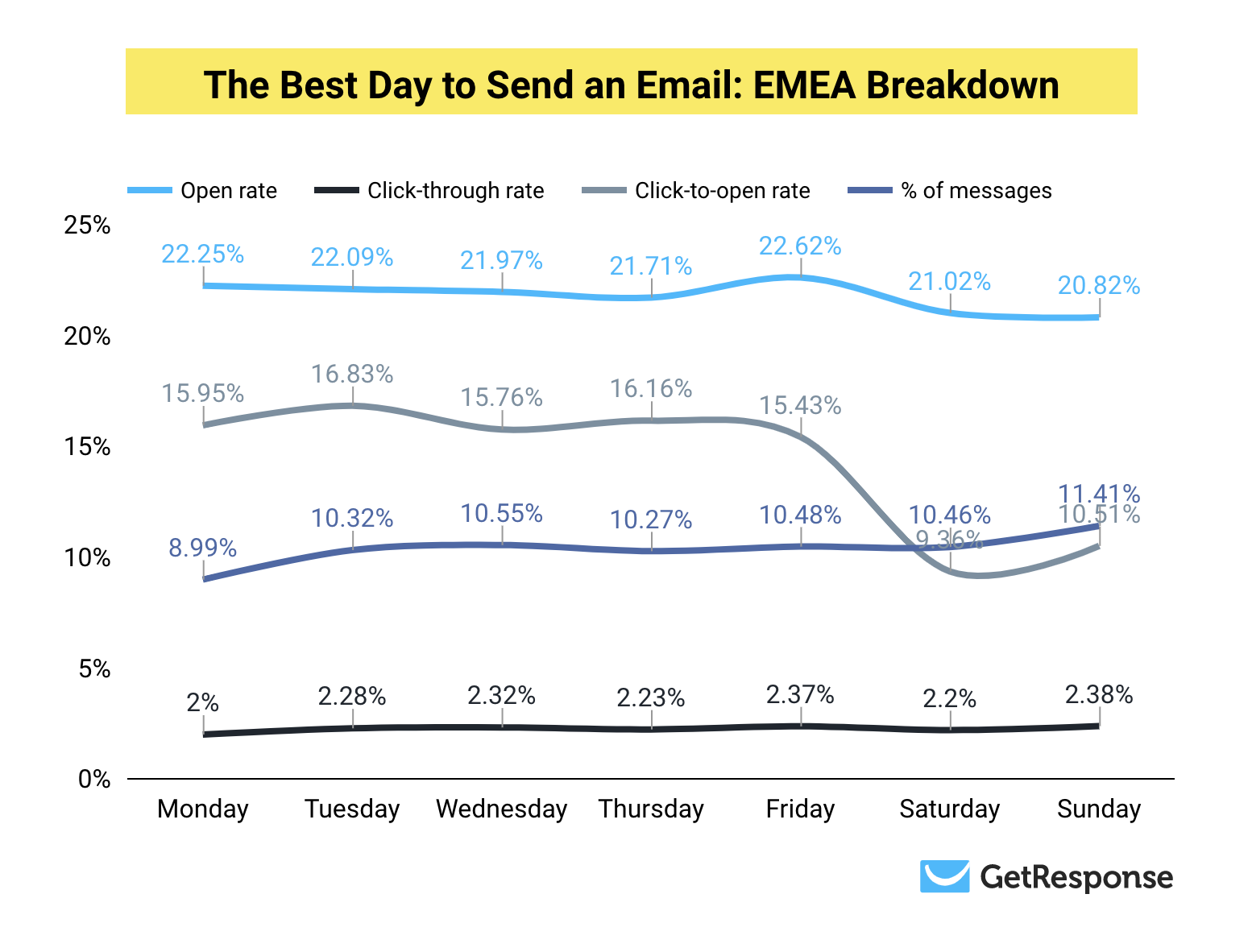If you’re an email marketer, I bet you’ve asked yourself this question at some point – what is the best time to send email?
Like you, we’ve also wondered about it. So, we decided to refresh (and expand) the study we’ve previously run and identify the best days and times to send emails in 2020.
And today, we’re happy to share the findings with you.
Related: Email Marketing 101 – How to succeed with email marketing.
What we did
We’ve analyzed over 2.85 million emails sent by GetResponse customers within the first two quarters of 2020.
In our analysis, we only included SMB customers and tracked campaigns that went out to at least 1,000 contacts.
We looked at what time and day customers sent their email campaigns and what open, click-through, and click-to-open rates they generated.
What makes this study unique is that we also divided the results by our customers’ location.
Thanks to this, on top of seeing the global results, you’ll also be able to review the data individually for the following regions: US & Canada, DACH, EMEA, Asia-Pacific, CEE, and LATAM.

When to use this data
We could argue that the best time to send an email doesn’t even exist. Or perhaps it does, but it’s not something that’s shared among a larger group of subscribers. It’s largely an individual thing.
While this may be right, there are times when we’ve got no other option but to schedule our email campaigns by hand.
Here are some scenarios when that’s often the case:
- You want everyone in your audience to receive your message at the same time. For example, when running a 24-hour flash sale campaign.
- Your email list is new, and you don’t have enough data to feed the algorithm.
- You prefer to send your campaigns at a specific time and want your audience to form a habit of opening their inbox at a particular hour.
- You have to time your campaigns according to external events, e.g. stock market trading hours.
So, if you have to select the best time to send your emails by yourself, this data will prove useful.
And is it even worth the hassle?
Just consider the numbers: Even if you can increase your email click-through rates by 0.5 percentage points (from 2% to 2.5%), it could translate into a 25% growth in sales revenue from that one campaign. For most businesses, that means a massive difference.
Just keep in mind that every audience is different. So, compare these results with what you’ve been experiencing or what your gut feeling keeps telling you. Use it as a starting point for more complex tests that you’ll do on your target audience.
When it’s better to use send-time optimization algorithms
Personally, I lean toward the idea that the best time to send an email isn’t universal.
Every person is different, and if working remotely has taught me anything, it’s that we’ve all got our own personal schedules and preferences.
Plus, there are many other factors that may affect what the optimal time for your campaign may be, like:
- What industry you’re in
- Who your target audience is and how they behave
- Where they’re located
- What season it is
- Anything uncommon that’s currently happening around
That’s why, if you don’t need to deliver your emails all at once, you may see better results if you tailor your communication to each subscriber’s needs.
The best part is, it doesn’t require any additional work on your side – that is if you use the right email marketing software. If you schedule your emails using a send-time optimization tool like GetResponse Perfect Timing, an advanced algorithm takes care of all the work for you.

With just one click, you can make sure that all your contacts receive your message when they’re most likely to engage with it.
Editor’s note: If you decide to send your emails by hand, here are a handful of tips on how you can send an email blast the right way.
The best time to send an email: global

The global data suggests that the single best time for sending emails was either 4 am (if judged by the resulting open rate) or 6 am (if you’re looking at the click-through rate).
While 4 am may seem more like an outlier since only 1.2% went out at that time, the 6 am when 3.95% of the messages went out looks more promising.

But does that mean you should send your emails early in the morning? Not necessarily.
If your target audience is likely to read your messages first thing in the morning after they wake up, then, by all means, try sending them at 6 am.
This approach will make it more likely for your emails to land at the top of your contacts’ inboxes, pushing the emails from the night before further down.
However, if it’s unlikely that your audience would read and act upon your emails this early in the day, you should pick the time that makes the most sense for them.
A rule of thumb suggests that aiming your emails to go out between 8 am and 5 pm is a safe bet.
Within that frame, both the open and click-through rates are the most stable. That’s also when over 64% of all the marketing emails went out.
The best day to send an email: global

Our global data suggests that the days of the week play a smaller role if you’re optimizing your campaigns for open and click-through rates.
Except for the weekends, when the average open rates were the lowest, there’s little difference between individual days of the week.

Friday, which topped the list in terms of opens, had an average open rate of 20.58% – only 0.73% more than Thursday, placed at the bottom.
In terms of clicks, Tuesday scored best, achieving a click-through rate of 2.33%. Still, that’s only 0.14% more than the lowest score, even when we count in the weekends.
That said, you should always consider who you’re targeting and when they’re likely to engage with your emails.
Come up with a hypothesis and test it. Who knows, maybe you’ll find a sweet spot when your audience is most active that’s also less competitive?
The best time to send an email: US & Canada

The US & Canada results are relatively similar to what we’ve observed globally.
Marketers who send their emails at 4 am can count on the highest open-rates, while those who do it at 6 am see the highest click-through rates.
Most email marketers send their newsletters around the standard business office hours, i.e. 6 am – 6 pm. Emails sent within that time frame account for 81.14% of all the messages we analyzed.
Globally, we could see that the open and click-through rates remained relatively stable throughout the day. In the US & Canada, however, these metrics seem to drop more significantly after 10 am.

In general, if you’re sending emails to an audience in the US & Canada, you’ll have to pay more attention to when you send your messages. If you can’t target each subscriber separately, you’re better off deploying your email campaigns at 6 am or around 9-10 am.
The best day to send an email: US & Canada

If you’re targeting an audience in the US & Canada, you’ll want to time your campaigns with slightly more attention.
Friday and Monday are the two top-performing days in terms of open rates. They’ve achieved average open rates of 20.42% and 20.11%, respectively. Sunday, which ended at the bottom of our list, only got a 17.81% open rate.

In terms of clicks, Thursday and Tuesday took the lead. The average CTRs scored on those days were 2.70% and 2.68%. The difference between Thursday and Monday, which had the lowest click-through rate, was 0.29 percentage points.
You could argue that it’s not a lot, but it’s more than double compared to what we saw globally.
The best time to send an email: LATAM

This is a perfect example of data that could point us in the wrong direction.
At first glance, it seems that the most optimum time for sending your email campaigns is 2 am. That’s when we observed both the highest open and click-through rates.
The problem? Only 0.53% of the emails we observed in the Latin American region went out at that time. That means the sample’s small, while the chances of an error are big.

Moving past the 2 am slot, we can see that the average results are relatively stable, starting from 6 am till 4 pm.
Besides the fact that the optimum timeframe ends sooner (at 4 pm), these results are similar to what we’ve observed for other regions.
Generally, if you’re targeting the Latin American region, you’re better off sending your email campaigns in the morning and early afternoon.
Most marketers send their emails between 6 am and 4 pm. This is most likely because they want their audience to read their messages right after coming in or before leaving their office.
The best day to send an email: LATAM

Monday seems to be the best day for sending your newsletters if you’re targeting the LATAM audience.
It was the day when we observed both the highest open (22.48%) and click-through rates (2.12%).

Still, days of the week don’t seem all that important if you’re optimizing for opens and clicks.
If you’ve got an engaged audience and top-quality content, you don’t need to worry about the best day to send emails.
Although Monday was the top performer in the Latin American region, it wasn’t significantly better than other days of the week.
The only day that stands out is Sunday, which ranked the worst both in the open rates (18.18%) and click-through rates (1.39%).
The best time to send an email: CEE

Most of the regions we analyzed so far got relatively stable engagement rates throughout the day. After the initial peak, the metrics remained flat till the late afternoon.
The story’s quite different for Central and Eastern Europe. Here, we can see two peaks. The first one between 10 am and 12 pm, and the second one between 5 pm and 7 pm.
Interestingly, the latter ends with the top-performing hour, 7 pm, when we saw the most opens and clicks.

This suggests that consumers in the CEE region start engaging with emails a bit later than elsewhere, but they also keep responding to them after the standard working hours.
For marketers targeting the CEE region, this leaves more room for flexibility as they don’t need to worry about launching their campaigns first thing in the morning.
The best day to send an email: CEE

Marketers targeting the CEE audience have the highest chances of getting their messages opened and clicked if they send their campaigns early in the week.
The email engagement rates are at their top on Monday (20.42% OR, 2.32% CTR) and continue to decline throughout the week slowly.

The best time to send an email: Asia-Pacific

The results in the Asia Pacific region are somewhat surprising.
For the most part, we’re still seeing that marketers get relatively decent open and click-through rates around the standard business hours. Specifically, the most optimum time frame lasts somewhere between 9 am and 6 pm.

However, what’s surprising is that marketers continue to send their emails later in the night. Over 18% of all emails went out between 9 pm and 2 am.
Although these emails see lower open rates, their CTRs aren’t always low. 11 pm topped the list in terms of click-through rates, scoring 3.11%.
The best day to send an email: Asia-Pacific

If your target audience is in the Asia-Pacific region, consider sending your emails in the first half of the week.
That’s when consumers have shown the highest engagement rates and you’re most likely to generate high open and click rates.
That said, although Tuesday and Wednesday topped our ranking, other days of the week aren’t that far behind.

Just be careful about sending your emails on weekends. These tend to perform slightly worse.
The best time to send an email: EMEA

If you’re targeting Europe, the Middle East, and Africa, you should aim your campaigns to go out between 8 am and 7 pm.
That’s a long time-frame during which you can expect high opens and click-throughs on your email campaigns.

That said, the highest click-through rate was outside of this time frame, at 1 am. But that score is based only on 0.64% of all emails, which suggests that the data may not be very accurate.
For more ideas on how to optimize your email campaigns, refer to these all-time favorite resources:
2. Email Marketing Best Practices
3. How to Segment Your Email List
The best day to send an email: EMEA

Friday and Monday ranked at the top in the EMEA region. That’s when the email campaigns we analyzed had the highest open rates and click-through rates.

Surprisingly, the results for all the other days were relatively similar. Even weekends, where we usually see much worse results, performed well.
The open rate averaged between 20.82% and 22.62% throughout the entire week. While the average CTR was between 2% and 2.38%.
The best time to send an email: DACH

DACH is known for its exceptionally high email engagement rates, which relates to how strict the data regulations are in this region.
Nonetheless, if you want to maximize your chances of converting your email subscribers, try aiming for 8 am or between 2 to 5 pm.
These timeframes saw both very high open and click-through rates and were also popular among marketers.

That said, we reported the highest OR at 11 pm, but that number’s based only on 0.52% of all the emails we analyzed.
The best day to send an email: DACH

Now in terms of send-day optimization, DACH is an interesting region.
Unlike in any other area we analyzed so far, DACH saw the highest open rates on Sunday.
In terms of the CTR, Friday topped the ranking. But Sunday didn’t come much later, ranking second.

Also, it seems that the weekend email campaigns are more common in DACH rather than any other region.
That isn’t to say you should move all your campaigns to weekends. But doing so once in a while might not be a bad idea.
Summing up
For the most part, all the regions saw similar trends – consumers show more engagement around the standard office hours.
That isn’t to say that you shouldn’t be reviewing the data on a regional level.
The standard office hours – and higher engagement times – aren’t always the same in all countries or locations. In the CEE, for example, consumers continue to show high engagement rates even past 8 pm.
Each region tells a slightly different story and often shows some exciting results you wouldn’t have seen in the global analysis. DACH, for instance, has demonstrated exceptionally high email engagement on Sunday. The opposite of what we saw in most of the other locations.
Such insights could give you an advantage over your competitors and mean a significant increase in sales revenue.
And even if you just use it to run an A/B test that doesn’t end up moving the needle – you’ll be that much wiser. And you’ll learn even more about your target audience.
Read more on the GetResponse blog:
1. 10 best Mailchimp alternatives for 2024
